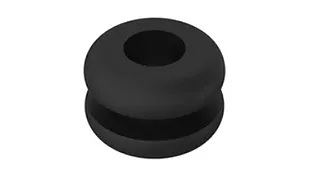Silicone rubber molding
Generally includes mastication, mixing, calendering or extrusion, molding, and vulcanization. Each process has different requirements for the product by several auxiliary operations. For compounding material to rubber, it must first masticate to improve its plasticity.; then, multiple rubber additives and rubber uniformly mix into a rubber compound through kneading; the rubber compound makes by extrusion and specific shape of the blank; then it is combined with the calendered or glued textile material (or with the metal material) to form a semi-finished product; finally, the plastic semi-finished product makes into a highly elastic final product after vulcanization.
The molding methods of rubber products include compression molding, extrusion molding, injection molding, and calendering molding.
1. Compression molding
The molding method uses commonly for manufacturing some rubber products with complex shapes, such as leather cups and sealing rings. The rubber material is placed in the mold for heating and molding with the help of the formed male and female molds.
2. Extrusion
The commonly used equipment for extrusion molding is a rubber extruder, and its working principle is similar to that of a plastic extruder. The material enters the barrel through the hopper of the extruder. With heat and rotation, the barrel and rotating screw push the rubber forward and plasticize it. Products or semi-products with complex cross-sectional shapes, such as tire tread rubber, inner tube, pure rubber tube, inner and outer layer rubber of rubber tube, and outer skin of wires and cables, etc.
3. Injection molding
Rubber injection molding is a production method in which the kneaded slurry is injected directly from the barrel through the feeding device into the model for vulcanization, which is similar to plastic injection molding. By injection molding, the molding cycle is short, the production efficiency is high, the labor intensity is small, and the product quality is high. Injection molding is mainly in producing seals, damping pads, and footwear.
The rubber injection molding process includes feeding, plasticizing, injection, pressure holding, vulcanization, mold release, etc. The molding diagram of the six-mode rubber shoe injection machine. First, the pre-mixed rubber material sends to the barrel through the hopper. Under the screw rotation, the rubber material pushes to the barrel’s front end along the spiral groove, and the rubber material advances along the spiral groove. Due to the intense stirring and deformation and the external heating of the barrel, the temperature rises rapidly, and the plasticity increases. When the rubber material reaches the front end of the barrel, the injection cylinder moves forward so that the nozzle at the front end of the barrel contacts the gate of the model. Then the injection cylinder is injected with glue, and the rubber material is injected into the mold cavity through the nozzle and maintained for some time. During the pressure holding process, the rubber material is subjected to the vulcanization stage at a high temperature until the mold ejects. The system enters the next glue injection stage and repeats the process.
4. Calendering
It is suitable for the manufacture of simple sheet-like and plate-like products. It is a method of pressing the mixed rubber into a film of a certain thickness and width through a calendar, called calendering.
Textile fiber materials used in some rubber products, such as tires, tapes, and hoses, must be coated with a thin layer of glue. Applying glue on the fibers is also called gluing or rubbing. The gluing process is generally also completed on a calendar.
The fiber material needs to be dried and dipped before calendering. The purpose is to reduce the water content of the fiber material to avoid moisture evaporation and foaming and increase the fiber material’s temperature to ensure the calendering process’s quality.
Dipping is a necessary process before hanging glue. The purpose is to improve the bonding performance of fiber material and rubber compounds.

